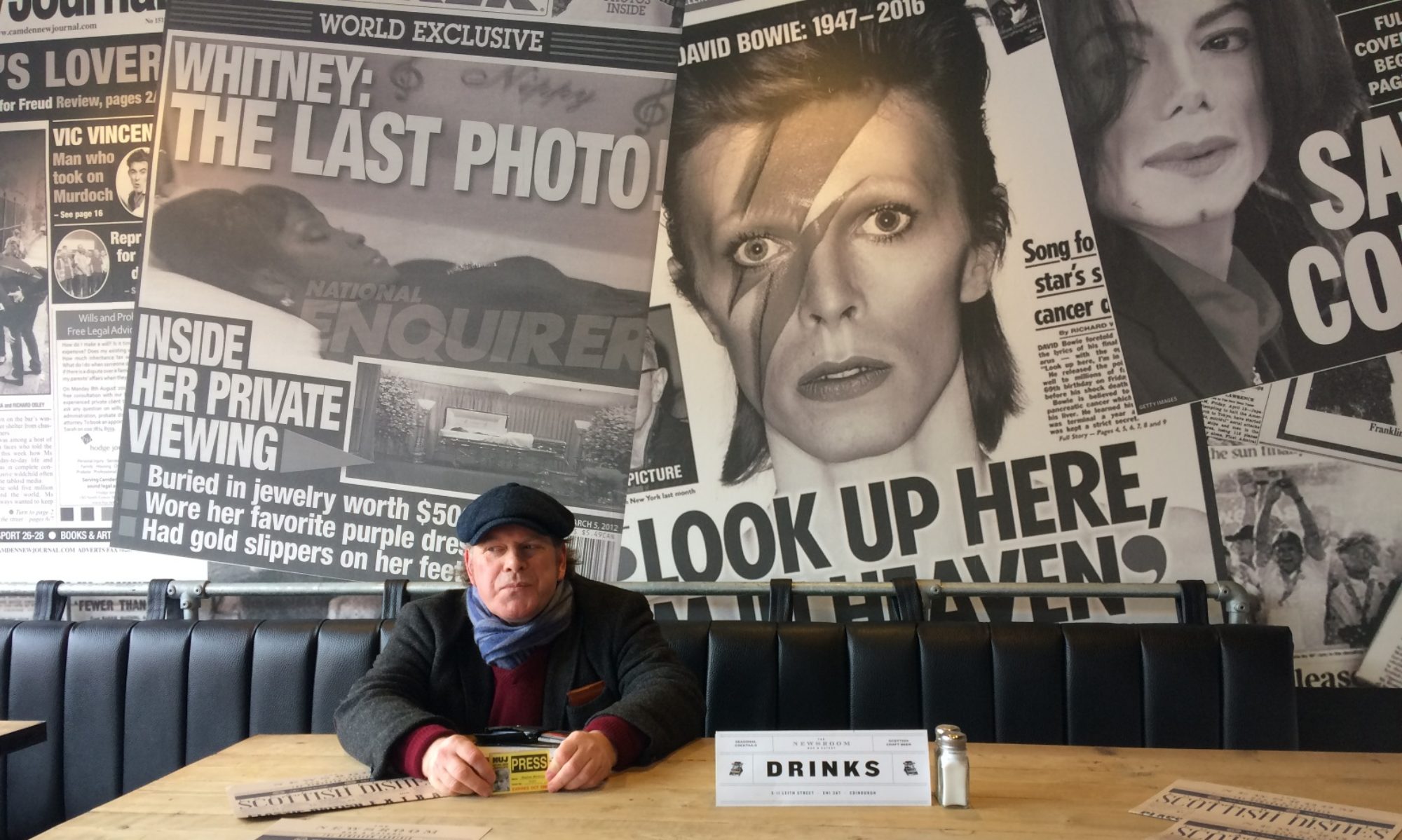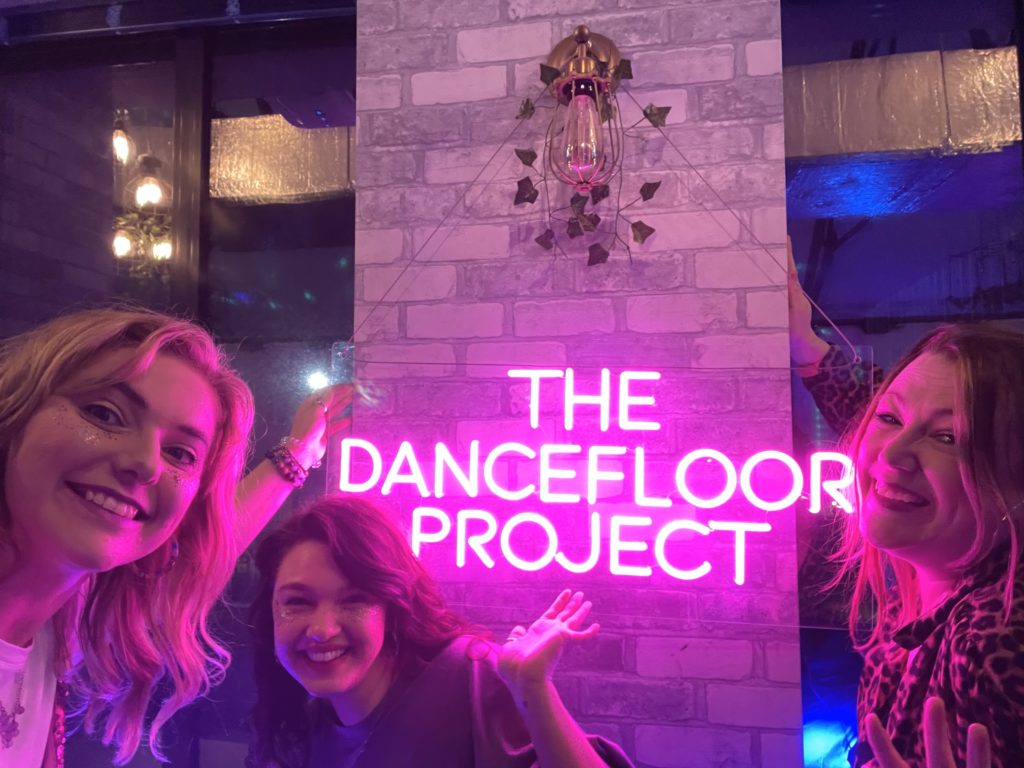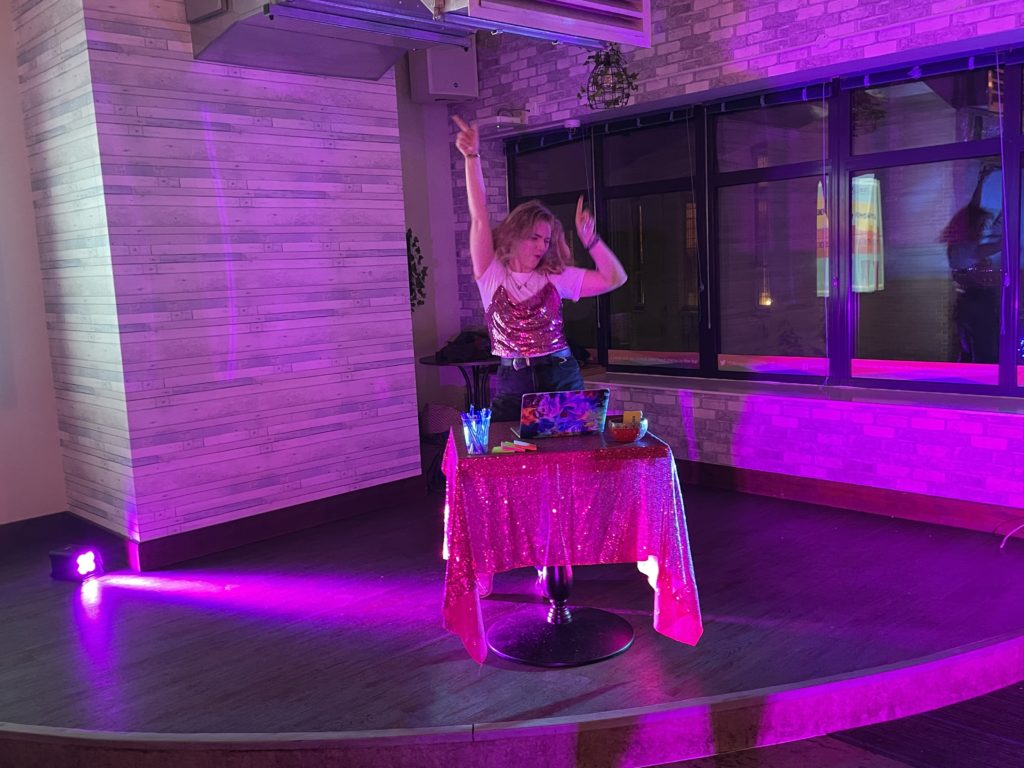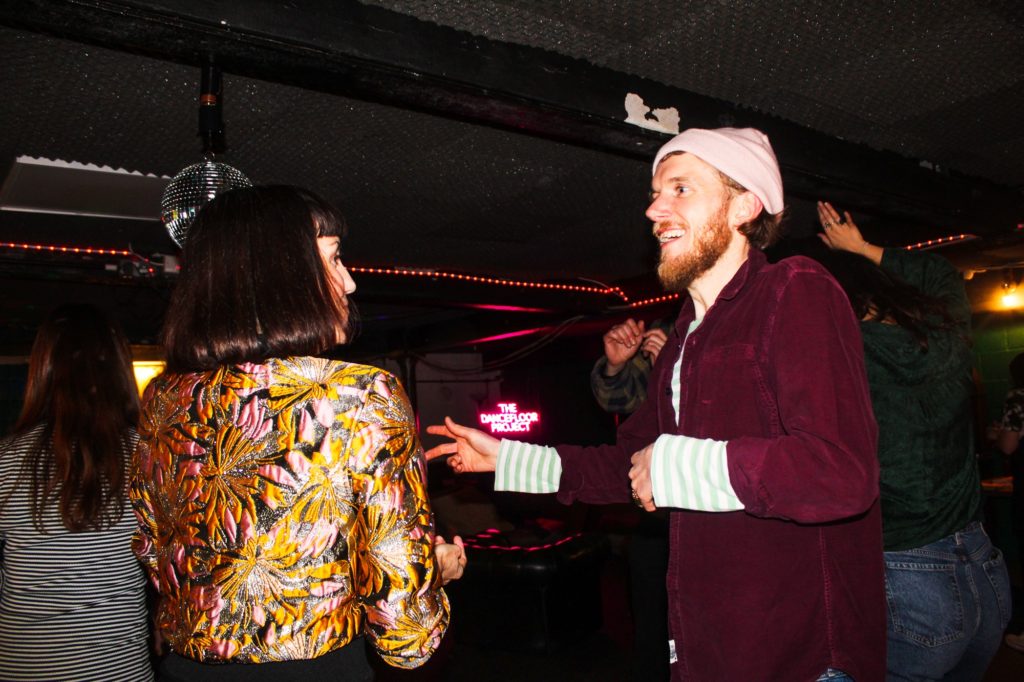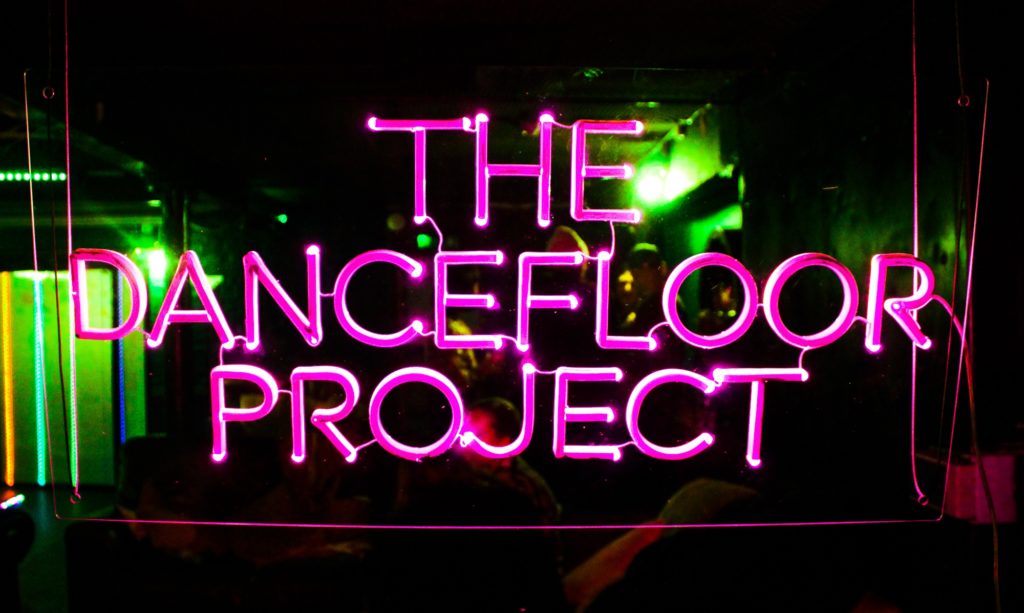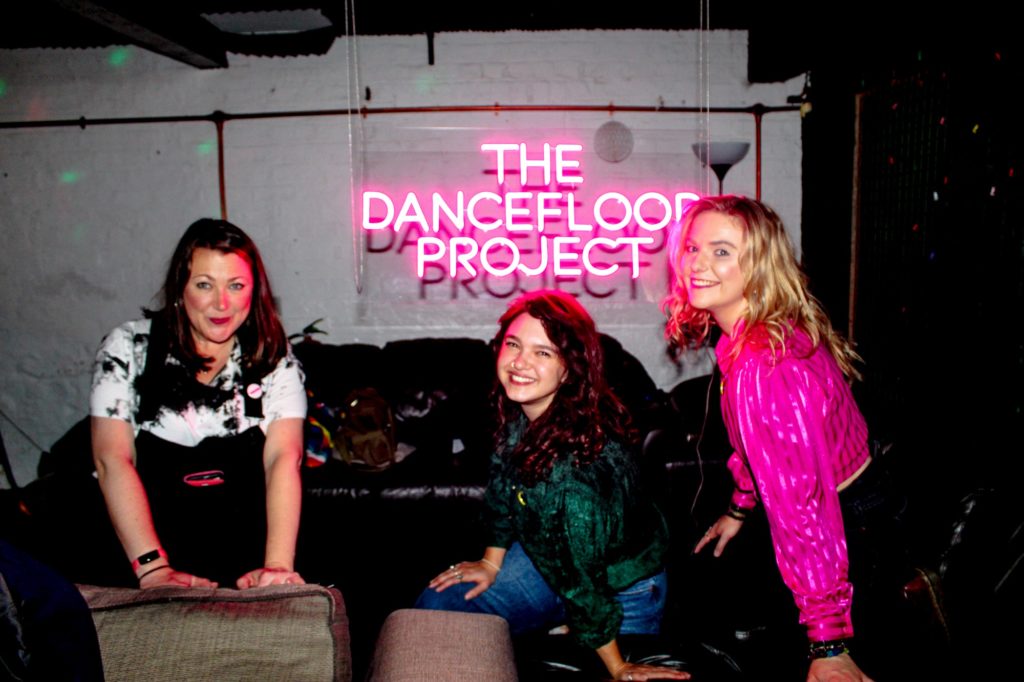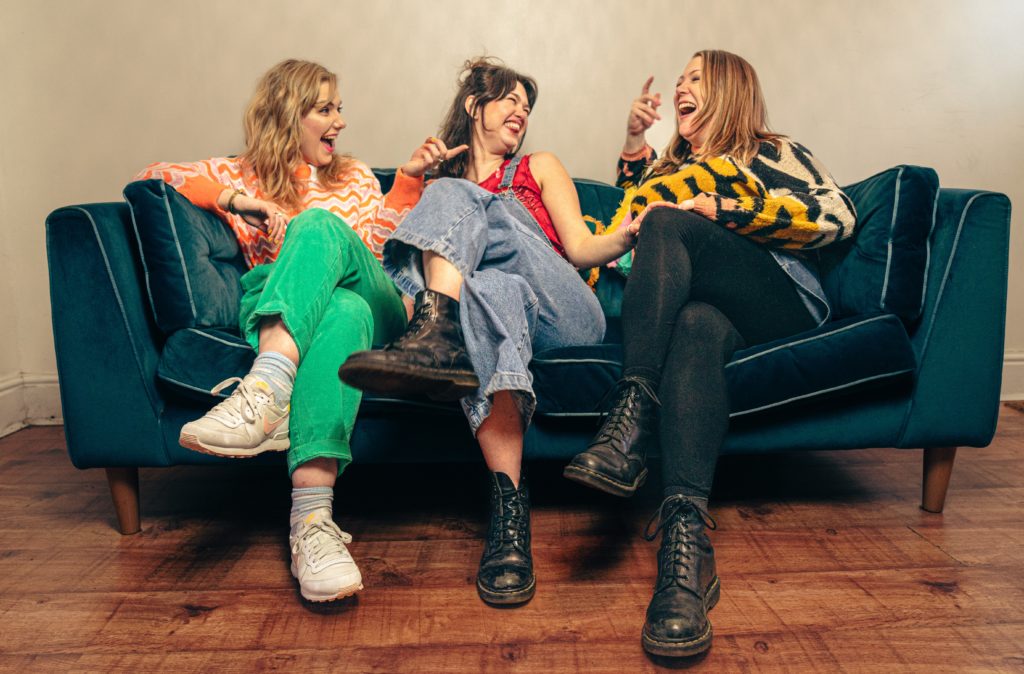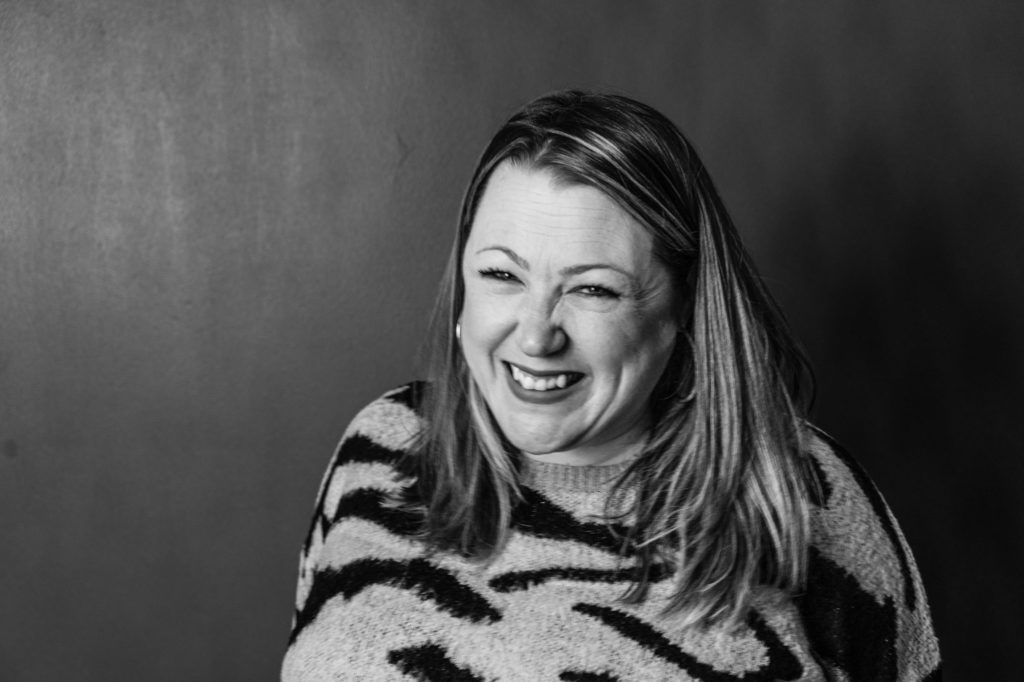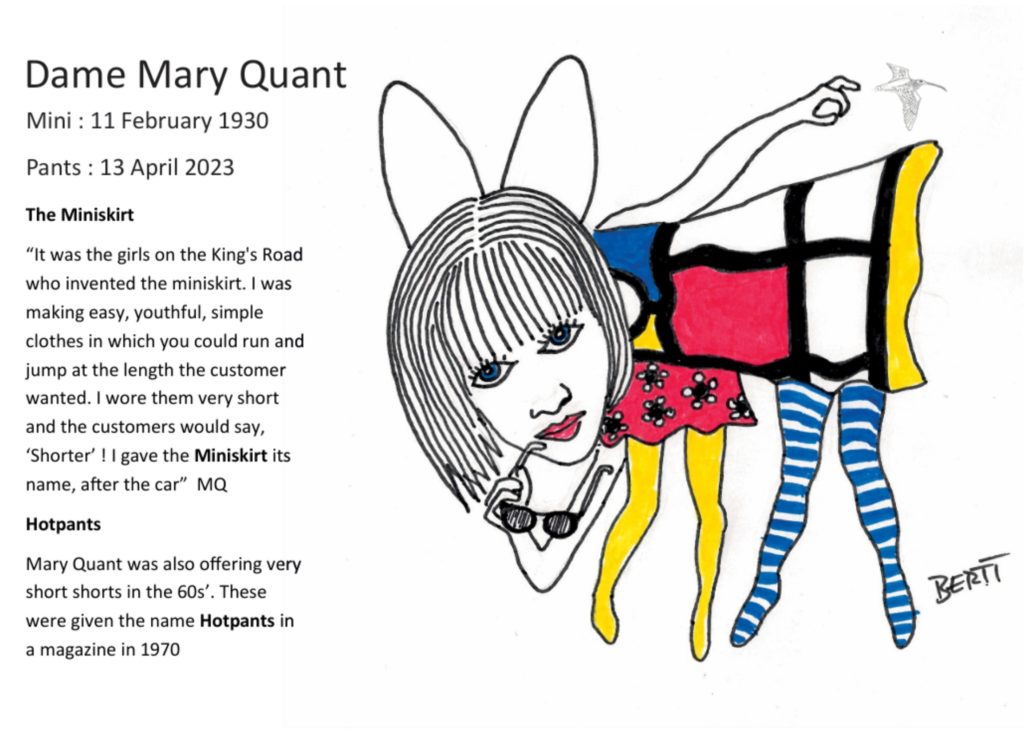
Good Rabbits Gone 4’s final catwalk for fashion designer Mary Quant, by Bertt deBaldock
TERRY Brett will launch the fourth volume of his cartoon rabbit tributes to celebrities and remarkable individuals at a charity event at the Golden Ball pub, in Cromwell Road, Bishophill Senior, York, on October 15.
Publishing costs are met by Terry’s gallery, Pyramid Gallery, in Stonegate, enabling copies to be given away from there, but “if they enjoy the book”, voluntary donations are encouraged in aid of St Leonard’s Hospice, York, in memory of Terry’s father, who died of prostate cancer.
The same applies at next Wednesday’s 4pm to 7pm event, where Terry/artist alter ego Bertt deBaldock will sign copies. Donations can be made to https://www.justgiving.com/page/terry-brett-8.
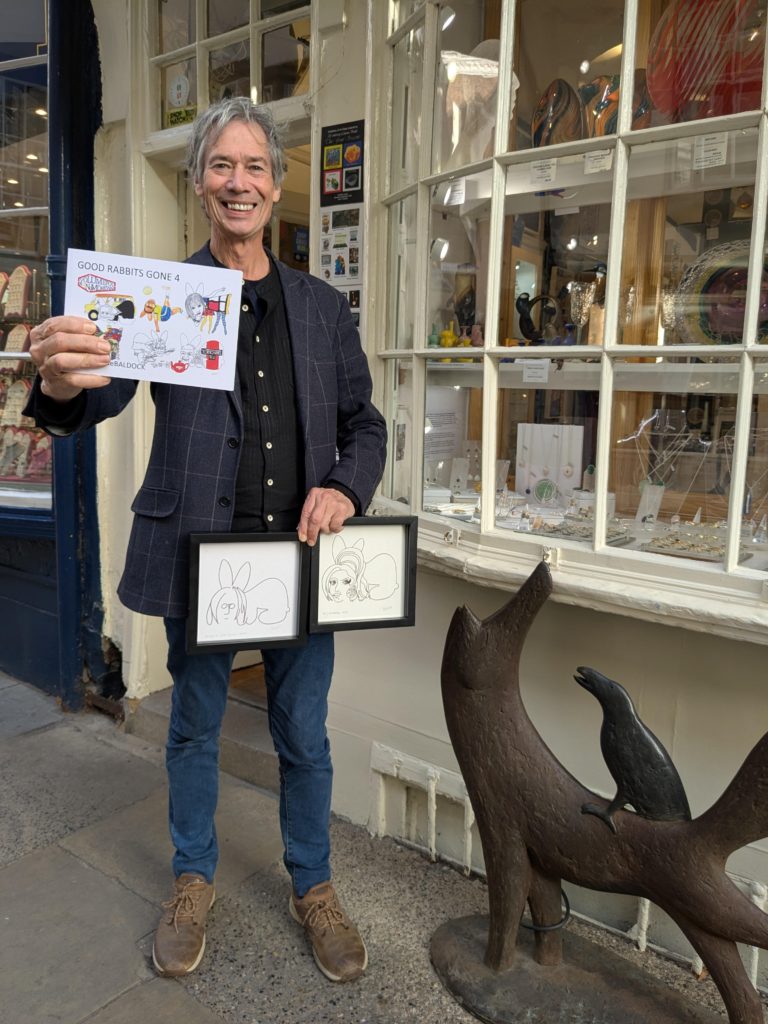
Terry Brett/Bertt deBaldock holds a copy of Good Rabbits Gone 4, No More War!, plus drawings of John Lennon and Amy Winehouse that will be for sale at the Golden Ball book launch, along with 15 other original works (£20 each, unframed, for this size)
The 104-page fourth compendium of death notices, entitled Good Rabbits Gone 4, No More War! covers the fallen from the spring of 2023 to the demise of 2024, with Mary Quant, Norman Ackroyd, Hairy Bikers’ Dave Myers, Melanie Safka, Shane MacGowan and Terry’s fellow cartoonist Bill Tidy among his favourite portraits this time.
Entertainers Barry Humphries, Paul O’Grady, Mike Yarwood and Len Goodman feature too. So do writers Benjamin Zephaniah, Martin Amis and Fay Weldon. Actors Dame Maggie Smith, Glenda Jackson and Bernard Hill. Musicians Burt Bacharach, Sinead O’Connor, David Crosby, Jeff Beck and Tina Turner. Footballers Bobby Charlton and Pele. Politicians Jimmy Carter and John Prescott. Artist Frank Auerbach. Even the Slender Billed Curlew, the first mainland bird to become extinct in West Asia, Europe and Northern Africa.
The cartoon drawings by “the Scribbler” Bertt deBaldock, the nom d’art of gallery owner, colour-blind artist, ukulele player and long-ago chartered surveyor Terry are each drawn in response to an individual’s death and then assembled in a book with Terry’s own witty tributes or poignant memories of the person.
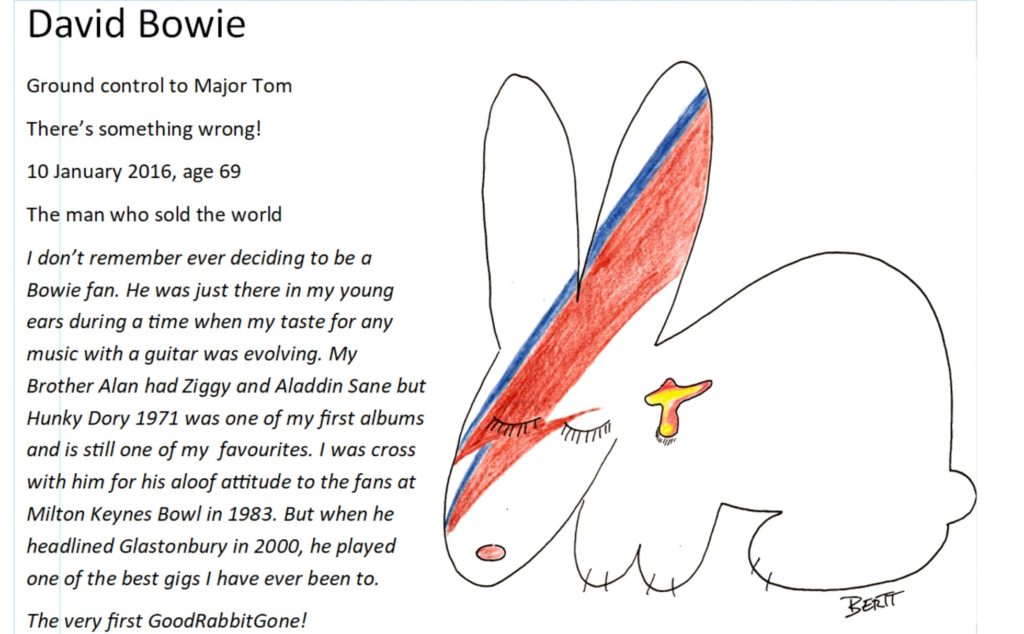
Terry Brett/Bertt deBaldock’s first Good Rabbit Gone, David Bowie, January 10 2026
Why use rabbits, Terry? “It started from my two daughters wanting a pet to replace our cat, back in 1995. I became carer for their pet rabbit and drew the cartoon, which then appeared on a Christmas card every year,” he says.
“Upset when David Bowie died in January 2016, I drew the rabbit shape with an Aladdin Sane-style red-and-blue lightning flash. Then Terry Wogan with a ‘Pudsey Bear ‘ bandage. Eventually I had so many scribbles that I put them in a book.
“Though a better answer is: the rabbit is the most peaceful and least destructive creature on the planet, yet also, potentially, one of the most successful. I like it that individuals, when they die, are reduced back to a persona that is not powerful, not celebrated and not destructive. It’s a leveller.”
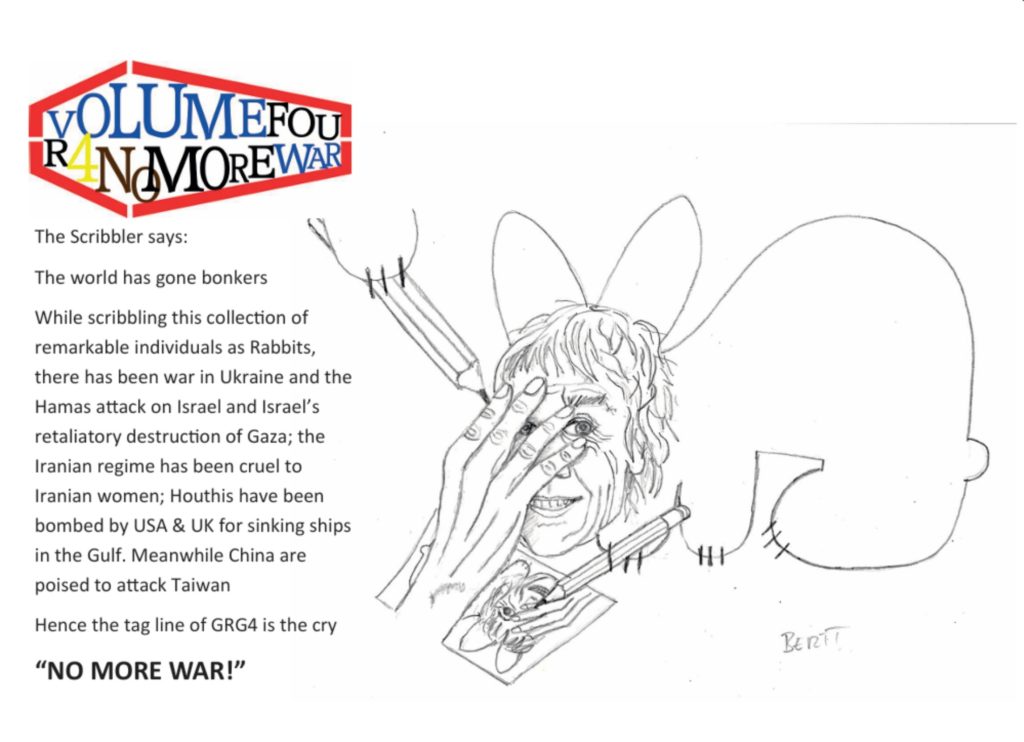
The Scribbler’s call for No More War! on the inside sleeve of Good Rabbits Gone 4
Terry introduces the latest volume with the sentiment “The world has gone bonkers”, then adds: “While scribbling this collection of remarkable individuals as rabbits, there has been war in Ukraine; the Hamas attack on Israel and Israel’s retaliatory destruction of Gaza; the Iranian regime has been cruel to Iranian women; Houthis have been bombed by the USA for sinking ships in the Gulf and China are poised to attack Taiwan. Hence the tag line is the cry ‘NO MORE WAR!’.”
Expanding on this thought, Terry says: “It seems to me that the disparity between rich and poor has become wider, nationally and individually. But the rich no longer have all the power and developing nations or marginalised groups are finding ways to steal something back from the powerful nations.
“Leaders of all nations seem to be prepared to risk everything in order to strengthen their own position, even though this will destroy the very thing that has allowed them to have such power.
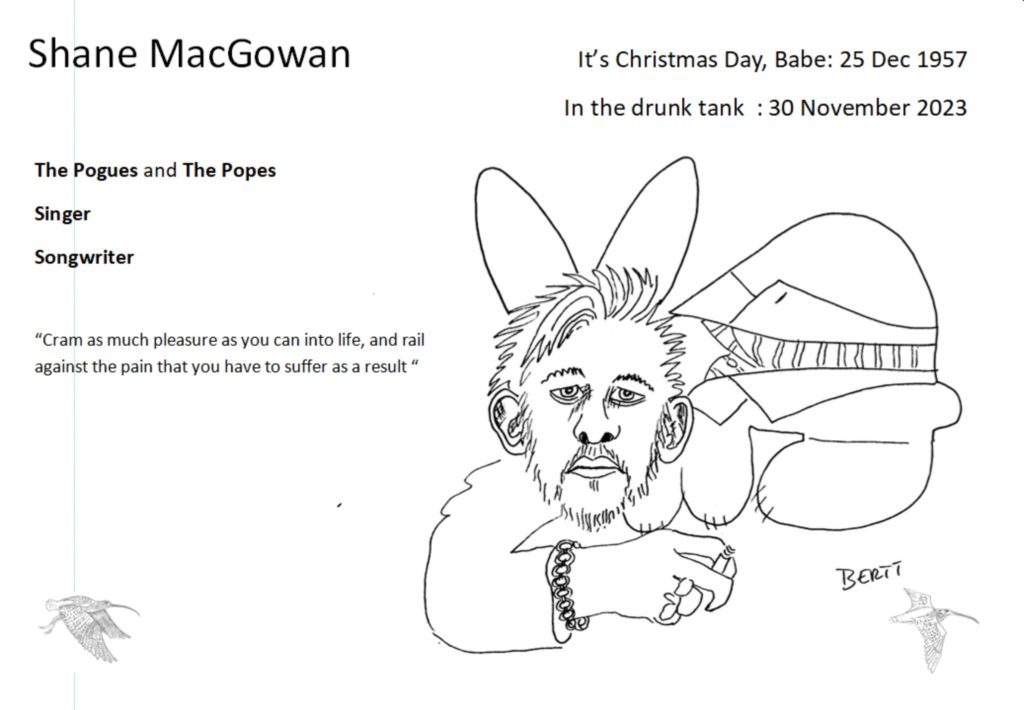
Good Rabbits Gone 4 raises a last glass to Shane MacGowan, by Bertt de Baldock
“I do not know what to make of it. It’s nothing new, but we can all see what is happening, thanks to technology! It just needs one person to make them (leaders of the big nations) and us all see sense: someone like Ghandi or Mother Theresa, or Mikhail Gorbachev – he could sort it.”
Summarising what qualities make someone quality to be a Good Rabbit Gone, Terry suggests: “Some of these ‘rabbits’ have been exceptional at one thing, either through talent or endeavour, and have become famous. But I’m really more interested in the effect that those individuals have had on others. I think ‘good’ means that the person has followed a path which has made a positive impact on others, or on the wider world which we need to conserve.”
Last month at the Stephen Joseph Theatre, Scarborough, Alan Ayckbourn introduced his new play Earth Angel with this thought: “We have to remember there are still good things floating about in the world today, though it’s often hard to see them. But the good is still there if we look for it.”
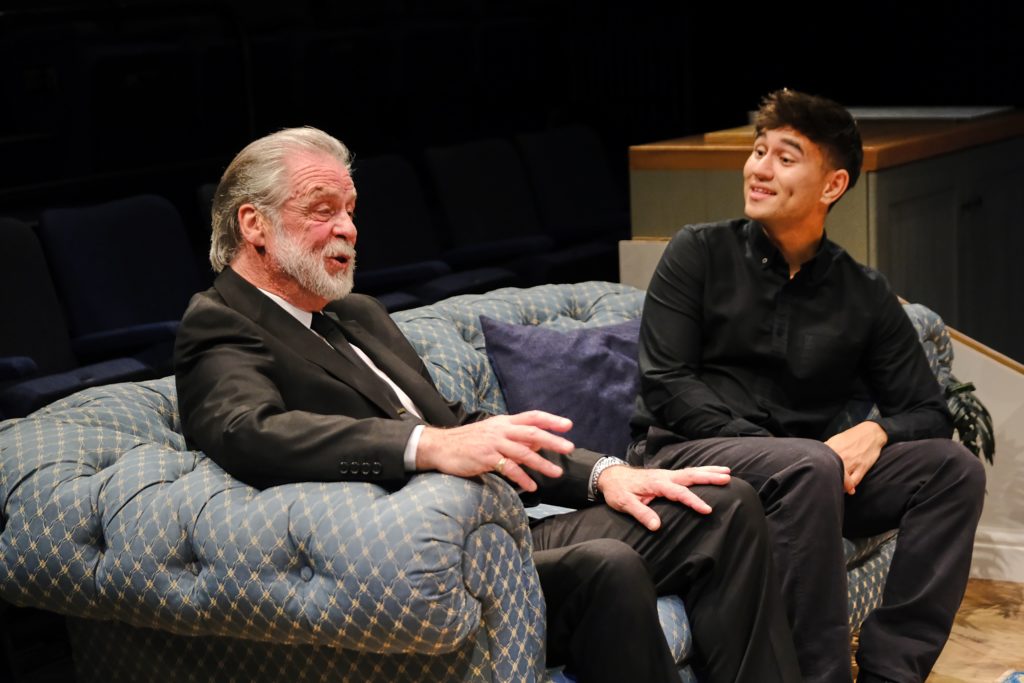
Asked to refract that philanthropic philosophy through the ethos of Good Rabbits Gone, Terry says: “I am constantly looking for those good things when researching the life stories of the deceased. And there are many good stories to tell.
“Fame or power is not enough for me, I need to find some evidence that the individual has either focused on some endeavour or creative expression, or has acted for the benefit of other people or the environment. If I cannot find some form of selfless intention in their character, then I lose interest.”
Terry highlights the “interesting story” of Camilla Batmanghelidjh (who died on January 1 2024). “She got into trouble with the media over poor book-keeping and alleged misuse of charity funds. The Kids Company, which had helped thousands of children, was forced to shut down due to false allegations that were dismissed in the high court,” he recalls.
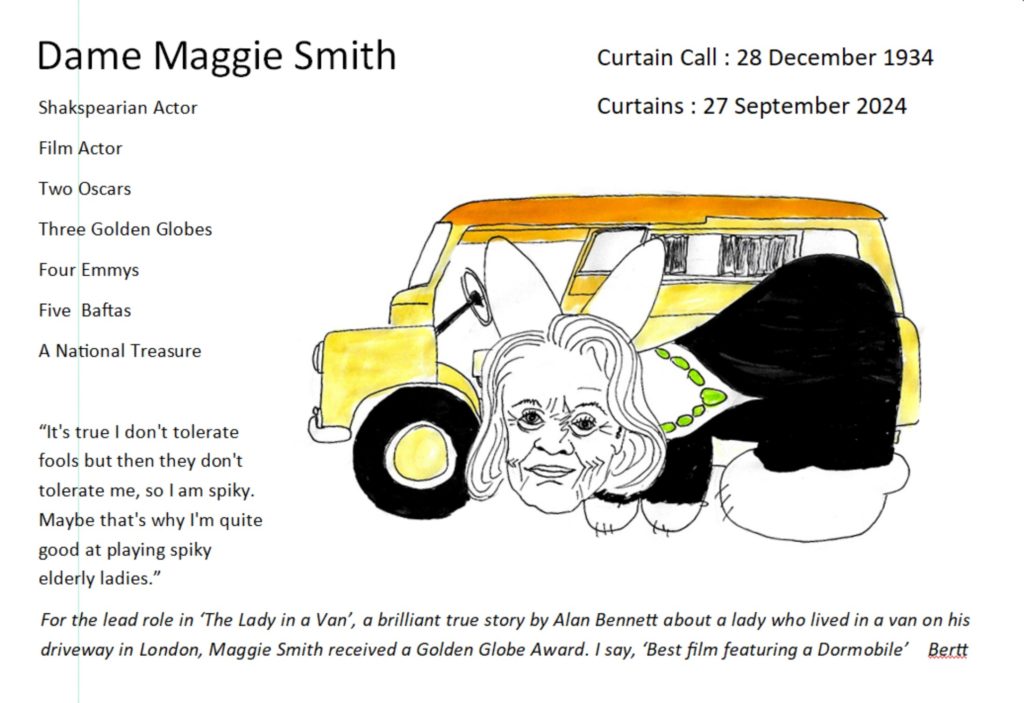
Good Rabbits Gone 4’s exit stage left to Dame Maggie Smith
“But from what I can read about her, she was very successful at assisting 36,000 marginalised children. She is said to have helped 96 per cent of them to return to full-time education and had a massive impact with respect to reduction of crime.
“There are many really good people in the world, devoting their lives to helping others, and their stories need to be celebrated.”
How would Terry define ‘good’ in 2025? “It’s a bit of a woolly word!” he says. “Some people in this world are so selfishly focused on their ambition, power or money, that they will never be ‘good’ in my eyes. I think ‘good’ means to have acted with the intention of making an improvement to the lives of others, or to the state of the world itself.”
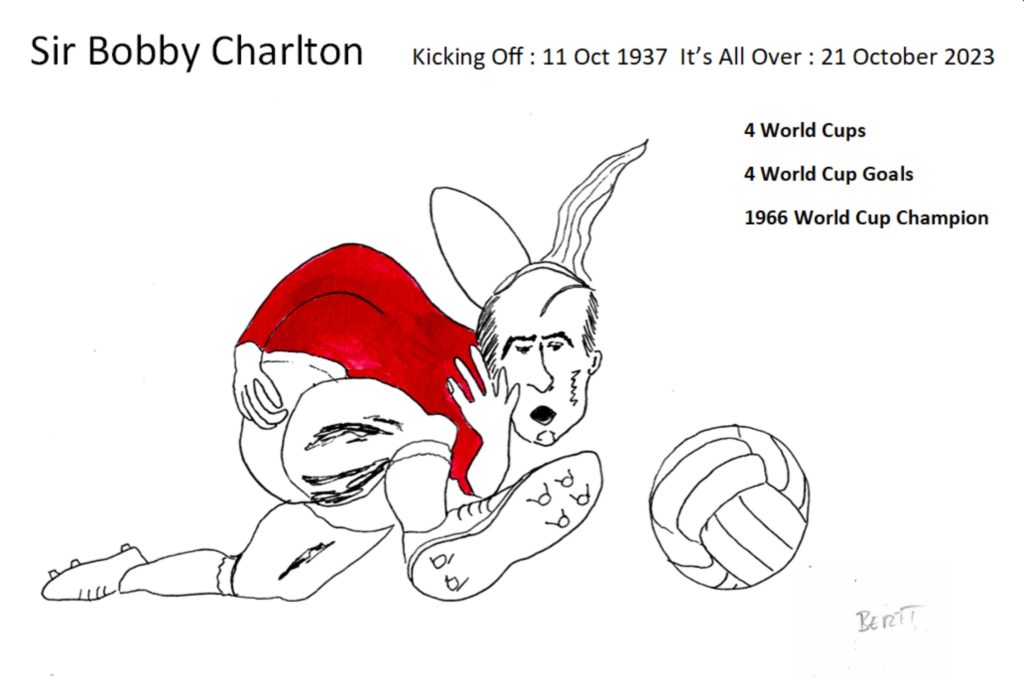
Good Rabbits Gone 4’s hair-flapping farewell to footballer Sir Bobby Charlton, by Bertt deBaldock
One more question…
How long does it take to construct each Rabbit obituary?
“I would say about a day of thinking, three hours’ reading and between 30 minutes and four hours drawing,” says Terry.
Oh, and one more thing…
How does Good Rabbits Gone 4 differ from past Good Rabbits Gone?
“I spent more time on this volume,” says Terry. “I have become fussier about the look of the scribbles and about who goes in. It’s maybe more serious, which sounds ridiculous when I say it!”
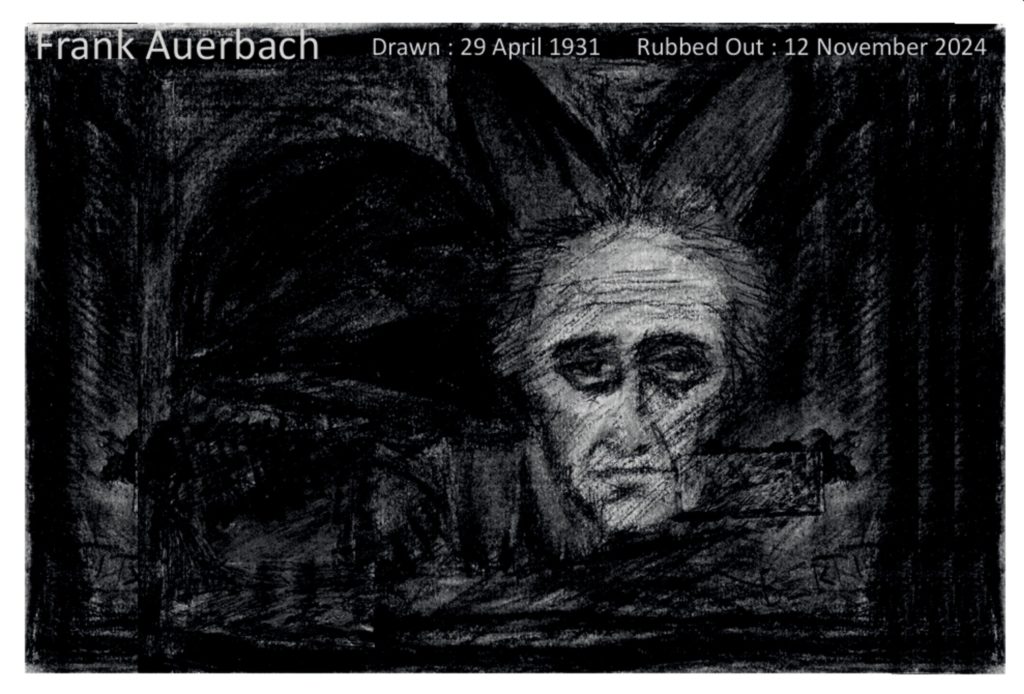
Good Rabbits Gone 4’s painterly dark goodnight to School of London artist Frank Auerbach, by Bertt deBaldock
